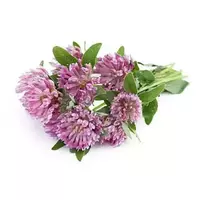Clover

Clover belongs to the genus of both annual herbaceous plants and perennials, which belong to the legume family. Other names for this plant are known, including honey stalk, red porridge, red-headed woodpecker, honey color, woodpecker, meadow shamrock or trinity.
Most of us are familiar with clover as a fodder crop and an excellent honeycomb, however, few people guess that it is also used to color the tissues to which the plant gives green color. In addition, dried clover heads are often used as a dressing for soups, while young stalks with leaflets can be added to fresh vegetable salads. Crushed clover leaves are dry added to bread when baked, which somewhat improves the quality of the finished product, and also uses it as a good substitute for tea.
Clover species
There are more than three hundred clover species in the world, which are distributed mainly in Europe, Asia, Australia, North America and Africa. In the countries of the former Union, for example, there are more than seventy clover species, most of which are valuable feed raw materials with a high protein content.
Despite the fact that now you can find a large number of clover species, not all of them are used for medicinal purposes. So, the most common among those is clover red (meadow), which is distinguished by branched stems and multi-flowered heads of dark pink color.
Clover composition
The most valuable in medicine are the inflorescences of this aromatic plant with apical leaves. Clover contains carbohydrates, steroids, phenol carboxylic acids, carotene, saponins, vitamins of groups B, C, K, E, as well as other substances that determine the properties of this plant useful for humans.
Clover benefits
In folk medicine, the inflammatory, diuretic, hemostatic, choleretic and anti-inflammatory properties of clover are known, therefore, this plant is recommended to be used in the form of decoctions, infusions and infusions in the treatment of a number of diseases. The benefits of clover for malblood, bronchitis, bladder inflammation, shortness of breath and bronchial asthma have been proven.
Flavonoids, which are contained in clover, have the ability to reduce blood cholesterol levels, and therefore the medicinal raw materials of this plant are recommended for use in the prevention of atherosclerosis. In addition, the benefits of clover roots are known, from which the antifungal agent trifolisin is isolated.
Harm to clover
The harm of clover can make itself felt in certain cases when the use of this plant is prohibited. For example, this applies to women in a position, since this plant can poorly affect the development of the fetus. The use of clover red is contraindicated for people with stomach disorders, for heart disease, as well as in the rehabilitation period after a stroke.
clover 0 kCal
Energy value of clover (Ratio of proteins, fats, carbohydrates - ju):
Proteins: 0 g (~ 0 kCal)
Fats: 0 g (~ 0 kCal)
Carbohydrates: 0 g (~ 0 kCal)
 Español
Español Français
Français Português
Português Русский
Русский 简体中文
简体中文 繁體中文
繁體中文 日本語
日本語 한국어
한국어 العربية
العربية Türkçe
Türkçe Қазақ
Қазақ Deutsch
Deutsch Italiano
Italiano Українська
Українська
